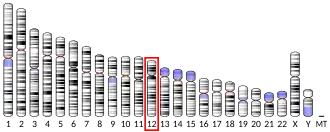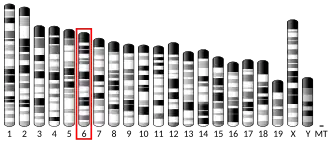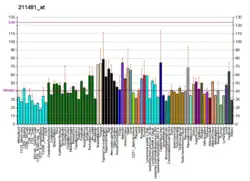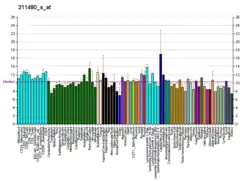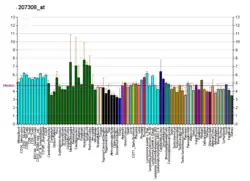Solute carrier organic anion transporter family member 1A2 is a protein that in humans is encoded by the SLCO1A2 gene.[5][6]
This gene encodes a sodium-independent transporter which mediates cellular uptake of organic ions in the liver. Its substrates include bile acids, bromosulphophthalein, and some steroidal compounds. The protein is a member of the SLC21A family of solute carriers. Alternate splicing of this gene results in three transcript variants encoding two different isoforms.[6]
See also
References
Further reading
- Meier PJ, Eckhardt U, Schroeder A, et al. (1998). "Substrate specificity of sinusoidal bile acid and organic anion uptake systems in rat and human liver". Hepatology. 26 (6): 1667–77. doi:10.1002/hep.510260641. PMID 9398014. S2CID 20039812.
- Kullak-Ublick GA, Hagenbuch B, Stieger B, et al. (1995). "Molecular and functional characterization of an organic anion transporting polypeptide cloned from human liver". Gastroenterology. 109 (4): 1274–82. doi:10.1016/0016-5085(95)90588-X. PMID 7557095.
- Kullak-Ublick GA, Beuers U, Fahney C, et al. (1997). "Identification and functional characterization of the promoter region of the human organic anion transporting polypeptide gene". Hepatology. 26 (4): 991–7. doi:10.1002/hep.510260429. PMID 9328325. S2CID 43606355.
- Kullak-Ublick GA, Fisch T, Oswald M, et al. (1998). "Dehydroepiandrosterone sulfate (DHEAS): identification of a carrier protein in human liver and brain". FEBS Lett. 424 (3): 173–6. doi:10.1016/S0014-5793(98)00168-9. PMID 9539145. S2CID 21231745.
- König J, Cui Y, Nies AT, Keppler D (2000). "Localization and genomic organization of a new hepatocellular organic anion transporting polypeptide". J. Biol. Chem. 275 (30): 23161–8. doi:10.1074/jbc.M001448200. PMID 10779507.
- Tamai I, Nezu J, Uchino H, et al. (2000). "Molecular identification and characterization of novel members of the human organic anion transporter (OATP) family". Biochem. Biophys. Res. Commun. 273 (1): 251–60. doi:10.1006/bbrc.2000.2922. PMID 10873595.
- Speek M (2001). "Antisense Promoter of Human L1 Retrotransposon Drives Transcription of Adjacent Cellular Genes". Mol. Cell. Biol. 21 (6): 1973–85. doi:10.1128/MCB.21.6.1973-1985.2001. PMC 86790. PMID 11238933.
- Strausberg RL, Feingold EA, Grouse LH, et al. (2003). "Generation and initial analysis of more than 15,000 full-length human and mouse cDNA sequences". Proc. Natl. Acad. Sci. U.S.A. 99 (26): 16899–903. Bibcode:2002PNAS...9916899M. doi:10.1073/pnas.242603899. PMC 139241. PMID 12477932.
- Lee W, Glaeser H, Smith LH, et al. (2005). "Polymorphisms in human organic anion-transporting polypeptide 1A2 (OATP1A2): implications for altered drug disposition and central nervous system drug entry". J. Biol. Chem. 280 (10): 9610–7. doi:10.1074/jbc.M411092200. PMID 15632119.
- Su Y, Zhang X, Sinko PJ (2005). "Human organic anion-transporting polypeptide OATP-A (SLC21A3) acts in concert with P-glycoprotein and multidrug resistance protein 2 in the vectorial transport of Saquinavir in Hep G2 cells". Mol. Pharm. 1 (1): 49–56. doi:10.1021/mp0340136. PMID 15832500.
- Kimura K, Wakamatsu A, Suzuki Y, et al. (2006). "Diversification of transcriptional modulation: Large-scale identification and characterization of putative alternative promoters of human genes". Genome Res. 16 (1): 55–65. doi:10.1101/gr.4039406. PMC 1356129. PMID 16344560.
This article incorporates text from the United States National Library of Medicine, which is in the public domain.
|
|---|
By group |
|---|
SLC1–10 |
|---|
| (1): | |
|---|
| (2): | |
|---|
| (3): | |
|---|
| (4): | |
|---|
| (5): | |
|---|
| (6): | |
|---|
| (7): | |
|---|
| (8): | |
|---|
| (9): | |
|---|
| (10): | |
|---|
|
| SLC11–20 |
|---|
| (11): |
- proton coupled metal ion transporter
|
|---|
| (12): | |
|---|
| (13): |
- human Na+-sulfate/carboxylate cotransporter
|
|---|
| (14): | |
|---|
| (15): |
- proton oligopeptide cotransporter
|
|---|
| (16): |
- monocarboxylate transporter
|
|---|
| (17): | |
|---|
| (18): | |
|---|
| (19): | |
|---|
| (20): | |
|---|
|
| SLC21–30 |
|---|
| (21): | |
|---|
| (22): | |
|---|
| (23): |
- Na+-dependent ascorbic acid transporter
|
|---|
| (24): | |
|---|
| (25): | |
|---|
| (26): |
- multifunctional anion exchanger
|
|---|
| (27): | |
|---|
| (28): |
- Na+-coupled nucleoside transport (SLC28A1
|
|---|
| (29): |
- facilitative nucleoside transporter
|
|---|
| (30): | |
|---|
|
| SLC31–40 |
|---|
| (31): | |
|---|
| (32): | |
|---|
| (33): | |
|---|
| (34): |
- type II Na+-phosphate cotransporter
|
|---|
| (35): |
- nucleoside-sugar transporter
-
-
-
-
- SLC35E1
- SLC35E2
- SLC35E3
- SLC35E4
|
|---|
| (36): | |
|---|
| (37): |
- sugar-phosphate/phosphate exchanger
|
|---|
| (38): |
- System A & N, sodium-coupled neutral amino-acid transporter
|
|---|
| (39): | |
|---|
| (40): |
- basolateral iron transporter
|
|---|
|
| SLC41–48 |
|---|
| (41): | |
|---|
| (42): | |
|---|
| (43): |
- Na+-independent, system-L like amino-acid transporter
|
|---|
| (44): | |
|---|
| (45): |
- Putative sugar transporter
|
|---|
| (46): | |
|---|
| (47): | |
|---|
| (48): | |
|---|
|
| |
|
|
|
see also solute carrier disorders |
